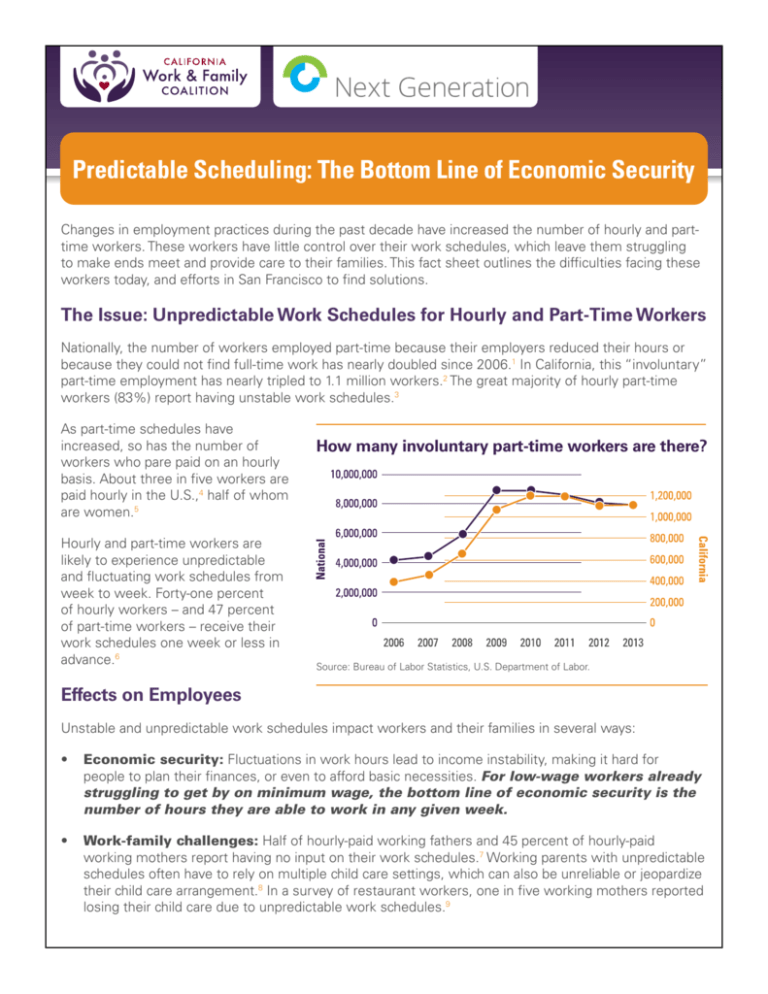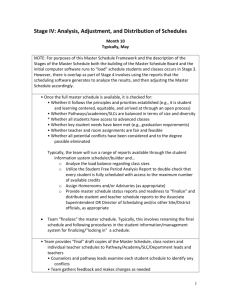Predictable Scheduling: The Bottom Line of Economic Security pdf
advertisement

Predictable Scheduling: The Bottom Line of Economic Security Changes in employment practices during the past decade have increased the number of hourly and parttime workers. These workers have little control over their work schedules, which leave them struggling to make ends meet and provide care to their families. This fact sheet outlines the difficulties facing these workers today, and efforts in San Francisco to find solutions. The Issue: Unpredictable Work Schedules for Hourly and Part-Time Workers Nationally, the number of workers employed part-time because their employers reduced their hours or because they could not find full-time work has nearly doubled since 2006.1 In California, this “involuntary” part-time employment has nearly tripled to 1.1 million workers.2 The great majority of hourly part-time workers (83%) report having unstable work schedules.3 As part-time schedules have increased, so has the number of workers who pare paid on an hourly basis. About three in five workers are paid hourly in the U.S.,4 half of whom are women.5 Hourly and part-time workers are likely to experience unpredictable and fluctuating work schedules from week to week. Forty-one percent of hourly workers – and 47 percent of part-time workers – receive their work schedules one week or less in advance.6 How many involuntary part-time workers are there? Source: Bureau of Labor Statistics, U.S. Department of Labor. Effects on Employees Unstable and unpredictable work schedules impact workers and their families in several ways: • Economic security: Fluctuations in work hours lead to income instability, making it hard for people to plan their finances, or even to afford basic necessities. For low-wage workers already struggling to get by on minimum wage, the bottom line of economic security is the number of hours they are able to work in any given week. • Work-family challenges: Half of hourly-paid working fathers and 45 percent of hourly-paid working mothers report having no input on their work schedules.7 Working parents with unpredictable schedules often have to rely on multiple child care settings, which can also be unreliable or jeopardize their child care arrangement.8 In a survey of restaurant workers, one in five working mothers reported losing their child care due to unpredictable work schedules.9 Leading the Nation: San Francisco’s Workplace Policies San Francisco has been a leader and innovator on workplace policies, including a locally-passed universal health care ordinance and paid sick leave. In 2013, San Francisco passed a historic Family Friendly Workplace Ordinance that gives workers the “right to request” flexible or predictable work arrangements. This is an important step forward, and has led to more public attention on predictable scheduling. The California Work & Family Coalition continues to work with local groups and legislators on this issue. The Coalition assisted Supervisor David Chiu to convene a task force with businesses and worker advocates to address unpredictable scheduling practices in San Francisco. Additionally, a coalition led by Jobs with Justice San Francisco is working with Supervisors Eric Mar and David Chiu to introduce the San Francisco Retail Workers Bill of Rights Ordinance. This proposed legislation will include several provisions to improve the schedule predictability for workers of “chain” establishments.11 Examples of Good Predictable Scheduling Practices Several businesses in San Francisco have implemented predictable scheduling with good results: Bi-Rite, a creamery and grocer, posts its schedules two weeks in advance, and gives workers at least five-days notice if changes occur. Zazie, a local restaurant, provides workers with core schedules, which include no more than one on-call shift per week used strictly to cover gaps in the schedule due to illness. Costco demonstrates its commitment to quality, full-time jobs by providing opportunities for part-time employees to gain more hours, cross-train, and transition to full-time status when there is availability.10 Nationally, Representatives George Miller and Rosa De Lauro introduced the Schedules That Work Act promoting fair and predictable work schedules. The bill provides workers the “right to request” flexible and predictable work schedules and prohibits employers from retaliation. It also regulates scheduling practices in the retail, food service, or cleaning industries.12 Senators Tom Harkin and Elizabeth Warren are expected to introduce the Senate version of the bill soon. July 2014 Notes 1. Bureau of Labor Statistics, U.S. Department of Labor, “Employment Level – Part-time for Economic Reasons, All Industries (2006 – 2013)” available at http://www.bls.gov/webapps/legacy/cpsatab8.htm. Data provided is seasonally adjusted and includes all industries. National data is reported as annual averages of monthly data. 2. Bureau of Labor Statistics, U.S. Department of Labor, “States: Employed and unemployed persons by full- and part-time status, 1997–2013p annual averages” (2014). Date of contact: June 2014. 2013 data is preliminary and subject to change. 3. Susan J. Lambert, Peter J. Fugiel, and Julia R. Henly, “Schedule Unpredictability among Early Career Workers in the US Labor Market: A National Snapshot” (Chicago: Employment Instability, Family Well-being, and Social Policy Network, 2014) available at http://ssascholars. uchicago.edu/einet/files/lambert.fugiel.henly_.executive_summary.b.pdf. 4. Bureau of Labor Statistics, U.S. Department of Labor, “Characteristics of Minimum Wage Workers, 2013” (2014). 5. Bureau of Labor Statistics, U.S. Department of Labor, “Table 44: Wage and salary workers paid hourly rates with earnings at or below the prevailing Federal minimum wage by selected characteristics” (2014) available at http://www.bls.gov/cps/cpsaat44.htm. 6. Susan J. Lambert and others, “Schedule Unpredictability among Early Career Workers in the US Labor Market: A National Snapshot.” 7. Susan J. Lambert and others, “Schedule Unpredictability among Early Career Workers in the US Labor Market: A National Snapshot.” 8. Liz Ben-Ishai, Hannah Matthews, and Jodie Levin-Epstein, “Scrambling for Stability: The Challenges of Job Schedule Volatility and Child Care” (Washington: Center on Law and Social Policy, 2014). 9. Restaurant Opportunities Centers United, et al., “The Third Shift: Child Care Needs And Access for Working Mothers In Restaurants” (2013). 10. From testimony provided at San Francisco Predictable Scheduling Task Force Meeting, May 16, 2014. 11. For more information, see the Formula Retail Bill of Rights: http://retailworkerrights.com/?page_id=187. 12. National Partnership for Women & Families and National Women’s Law Center, “The Schedules That Work Act: Section-by-Section Summary” (2014) available at http://www.nwlc.org/sites/default/files/pdfs/section-by-section_fact_sheet_final.pdf. The California Work & Family Coalition is a project of Next Generation. www.thenextgeneration.org







